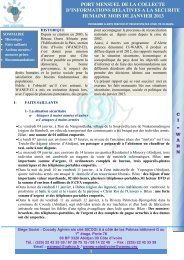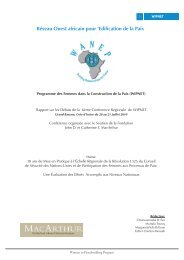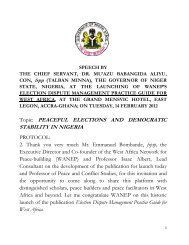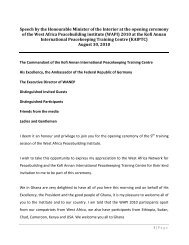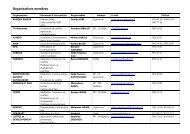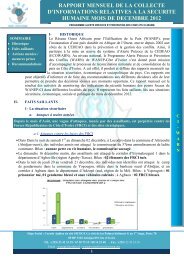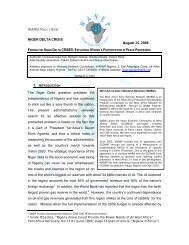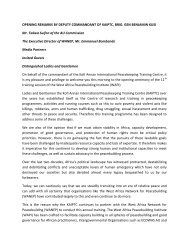DEVELOPMENT AND IMPLEMENTATION of National Action Plans ...
DEVELOPMENT AND IMPLEMENTATION of National Action Plans ...
DEVELOPMENT AND IMPLEMENTATION of National Action Plans ...
You also want an ePaper? Increase the reach of your titles
YUMPU automatically turns print PDFs into web optimized ePapers that Google loves.
Section 2: Process <strong>of</strong> Development <strong>of</strong> NAPsThe process <strong>of</strong> developing a NAP is as important as the final product. They have been/or canbe developed in many different ways (depending on the context) to meet the requirementsset by available resources, timeframe and actors involved. They can be stand alone orintegrated into existing policy frameworks.In planning for the development <strong>of</strong> NAPs, some pertinent questions need to be asked. Some<strong>of</strong> these and answers are provided below:Who should lead the process <strong>of</strong> the development <strong>of</strong> NAPs? - Development <strong>of</strong> NAPsshould be a government-led process, with governments being responsible for the planning,drafting, finalizing and approving the NAP. However, CSOs can be an initiator/catalyst, amonitor and source <strong>of</strong> expertise and guidance.Which ministry/department should coordinate the process? - Which ministriesshould coordinate the development depends on the context within the country. If thecountry is a Troop Contributing Country (TCC), the development should be led by theMinistry for Foreign Affairs or Ministry for Defence. If the country is conflict prone/recoveringfrom conflict, etc, the process should be coordinated by the Ministry for Gender/WomenAffairs and Social Development.Should a taskforce comprising <strong>of</strong> representatives from government ministriesand CSOs be set up? - Because <strong>of</strong> the broad nature <strong>of</strong> UNSCR 1325 and the fact that it hasimplications for all sectors, it is advised that a taskforce comprising <strong>of</strong> representatives fromrelevant government ministries and agencies and CSOs be established.Should it be a quick process involving a consultant or should it be a participatoryprocess between government and CSOs? – It should be a participatory process betweengovernment and CSOs as this is vital for the formation <strong>of</strong> an effective and applicable actionplan. However, a participatory process <strong>of</strong>ten takes longer and can be a source <strong>of</strong> greatfrustration but it has a better chance <strong>of</strong> success with action plans that are implementedat multiple levels and in close coordination. Also, a NAP stands a better chance <strong>of</strong> beingimplemented when it is designed in collaboration with the people that will be responsiblefor implementation and complemented by clear accountability and reporting mechanisms.What are the benefits <strong>of</strong> involving CSOs? – CSOs bring in a lot <strong>of</strong> value added to theNAP development processes as:»»They work on a wide range <strong>of</strong> issues that are covered by UNSCR 1325 and relatedresolutions;»»Raising <strong>of</strong> awareness and contribution to advocacy initiatives;»»Provision <strong>of</strong> important knowledge, input and critical views on security and genderrelated issues;»»They are an essential source for data collection, documentation and dissemination;»»They can provide perspectives on the socio-cultural roots <strong>of</strong> gender-based discriminationand armed, domestic, psychological and other types <strong>of</strong> gender-based violence;10



![English [266KB] - West Africa Network for Peacebuilding](https://img.yumpu.com/50460007/1/184x260/english-266kb-west-africa-network-for-peacebuilding.jpg?quality=85)
